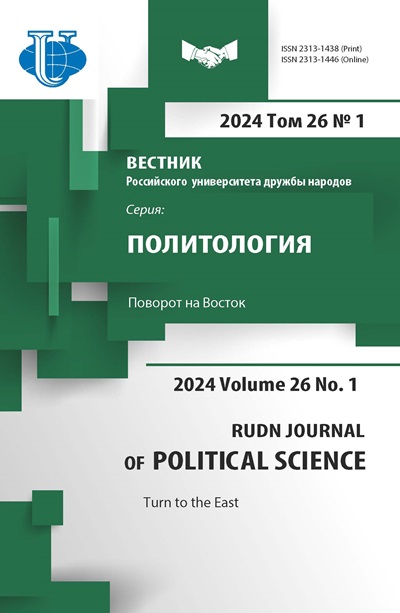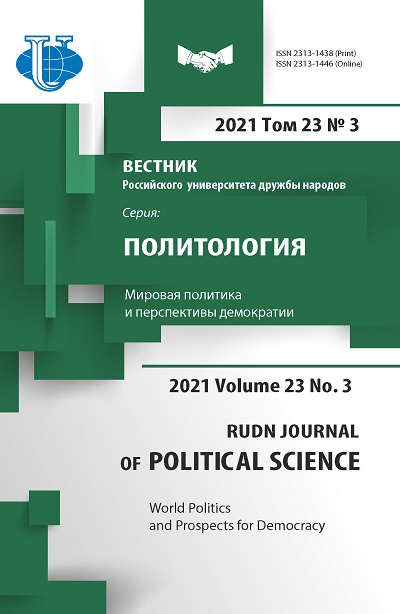The Concept of Multipolarity: Diversity of Approaches and Interpretations
- Authors: Soluianov V.S.1
-
Affiliations:
- Peoples’ Friendship University of Russia (RUDN University)
- Issue: Vol 23, No 3 (2021): World Politics and Prospects for Democracy
- Pages: 424-445
- Section: WORLD POLITICS AND GLOBAL LEADERSHIP
- URL: https://journals.rudn.ru/political-science/article/view/27307
- DOI: https://doi.org/10.22363/2313-1438-2021-23-3-424-445
Cite item
Full Text
Abstract
The author regards multipolarity as a question open for discussion, the variety of answers to which contribute not only to the comprehensive understanding of the phenomenon, but also to the perception of processes taking place in the world politics. The content of the multipolarity concept is revealed through the perspectives of realism, neorealism, civilizational approach, regional approach, liberalism, and constructivism. From the realism perspective, multipolarity can be considered as an objective reflection of the world development. The foundation of multipolarity consists in the growth of economic, military, and political potential of non-Western powers and the weakening of the US position as a global leader. Neorealism views multipolarity as a property of the international system which affects the behavior of states. The civilizational approach focuses on identifying civilizations as new actors and centers of power on the world stage. The regional approach highlights the importance of the increasing regionalization processes and creation of regional integration systems, which contribute to the formation of multipolarity in the context of the rise of regional powers and weakening of the US’s world position. Liberalism seeks to assess the impact of multipolarity on the stability and security of the international system. Along with the predictable attitude to multipolarity as a threat to peace and security, there is another more optimistic point of view. Constructivism regards multipolarity as a foreign policy discourse and a project of several states, primarily Russia. The results allow to see multipolarity from different perspectives and develop a more comprehensive and objective understanding of this phenomenon.
About the authors
Vladislav S. Soluianov
Peoples’ Friendship University of Russia (RUDN University)
Author for correspondence.
Email: soluyanov_vladislav@mail.ru
ORCID iD: 0000-0003-2489-3002
Postgraduate Student, Department of Comparative Politics
Moscow, Russian FederationReferences
- Ableev, S.R., Zolkin, A.L., & Marchenya, P.P. (2019). Geopolitical threats and sovereign Russia: Is the clash of civilizations growing? Journal of the Belarusian State University. Philosophy and Psychology, 7, 4–9. (In Russian).
- Acharya, A. (2009). Regional worlds in a post-hegemonic era. SPIRIT Working Papers, 1.
- Acharya, A. (2014). The end of the American world order. Polity.
- Acharya, A. (2020). The myth of the civilization state: Rising powers and the cultural challenge to world order. Ethics & International Affairs, 34(2), 139–156. doi: 10.1017/s0892679420000192
- Alcaro, R. (2015). The West, multipolarity, and the liberal order. The Brookings Institution. Retrieved April 25, 2021, from https://www.brookings.edu/blog/order-from-chaos/2015/04/10/the-west-multipolarity-and-the-liberal-order/
- Alcaro, R., Peterson, J., Greco, E. (Eds.). (2016). The West and the global power shift: Transatlantic relations and global governance. London: Palgrave Macmillan.
- Alekseenko, O.A. (2015). Globalization and regionalization as defining trends in the formation of a polycentric system of international relations. Moscow University Bulletin. Series 12. Political Science, 3, 28–34. (In Russian).
- Alekseeva, T. (2017). Theory of international relations in the mirrors of “Scientific pictures of the world”: What’s next? Comparative Politics Russia, 8(4), 30–41. (In Russian). doi: 10.18611/2221-3279-2017-8-4-30-41
- Allison, G. (2017). Destined for war: Can America and China escape Thucydides’s trap? Houghton Mifflin Harcourt.
- Blagden, D. (2015). Global multipolarity, European security and implications for UK Grand strategy: Back to the future, once again. International Affairs, 91(2), 333–350. doi: 10.1111/1468-2346.12238
- Blagden, D. (2019). Power, polarity, and prudence: the ambiguities and implications of UK discourse on a multipolar international system. Defence Studies, 19(3), 209–234. doi: 10.1080/14702436.2019.1643243
- Burton, G. (2021). Middle power behavior under multipolarity: Indonesia and Malaysia in the Middle East since the Arab uprisings. Asian Politics & Policy, 13(2), 228–247. doi: 10.1111/aspp.12577
- Butenko, V.A., & Mohammadi, S. (2020). Regionalization and the «new» regionalism. Law and Politics, 7, 105–113. (In Russian).
- Butler, S. (2018). Gemeinschaft as the Lynchpin of multilateralism: World order and the challenge of multipolarity. Irish Studies in International Affairs, 29, 17–34. doi: 10.3318/isia.2018.29.09
- Chaulia, S. (2019). Trumped: Emerging powers in a Post-American world. Bloomsbury India.
- Chebankova, E. (2017). Russia’s idea of the multipolar world order: origins and main dimensions. Post-Soviet Affairs, 33(3), 217–234. doi: 10.1080/1060586x.2017.1293394
- Coker, C. (2019). The rise of the civilizational state. Polity.
- Cont, S. (2020). Geopolitical shifts and the Post-COVID world: Europe and the multipolar system. IAI Commentaries. Retrieved January 23, 2021, from https://www.iai.it/en/pubblicazioni/geopolitical-shifts-and-post-covid-world-europe-and-multipolar-system
- Cooley, A., & Nexon, D. (2020). Exit from hegemony: The unraveling of the American global order. Oxford University Press.
- Cooley, A., & Nexon, D. (2020). Why populists want a multipolar world. Foreign Policy. Retrieved April 26, 2021, from https://foreignpolicy.com/2020/04/25/populists-multipolar-world-russia-china/
- De Keersmaeker, G. (2017). Polarity, balance of power and international relations theory. Palgrave Macmillan.
- De Santis, H. (2021). The right to rule: American exceptionalism and the coming multipolar world order. Lexington Books.
- Dreher, S. (2020). Religions in international political economy. Palgrave Macmillan, Cham.
- Dugin, A.G. (2013). The theory of a multipolar world. Moscow: Eurasiyskoe dvizhenie publ. (In Russian).
- Garzón, J. (2017). Multipolarity and the future of economic regionalism. International Theory, 9(1), 101–135. doi: 10.1017/S1752971916000191
- Gürcan, E.C. (2020). The construction of “post-hegemonic multipolarity” in Eurasia: A comparative perspective. The Japanese Political Economy, 46 (2–3), 127–151. doi: 10.1080/2329194X.2020.1839911
- Hadano, T. (2020). Multipolarity and the future of multilateralism: Towards “thick” peacekeeping in the Donbas Conflict. Global Policy, 11(2), 212–221. doi: 10.1111/1758-5899.12790
- Huntington S. (2020) The clash of civilizations. Moscow: AST. (In Russian).
- Jones, B. (2018). A not quite multipolar world. In McGann, M. (Ed.), Think tanks, foreign policy and the emerging powers (pp. 61–78). Palgrave Macmillan.
- Kausch, K. (2015). Competitive multipolarity in the Middle East. The International Spectator, 50(3), 1–15. doi: 10.1080/03932729.2015.1055927
- Kazarinova, D.B. (2018). Сrisis of liberalism in the assessments of its adherents. Russia in Global Affairs, 6. (In Russian). Retrieved March 9, 2021, from https://globalaffairs.ru/articles/krizis-liberalizma-v-oczenkah-ego-adeptov
- Kostin, A.I., & Izotov, V.S. (2015). Integration systems in the paradigm of globalistics: Updating of the research approaches. Moscow University Bulletin. Series 12. Political Science, 2, 7–32 (In Russian).
- Kurowska, X. (2014). Multipolarity as resistance to liberal norms: Russia’s position on responsibility to protect. Conflict, Security & Development, 14(4), 489–508. doi: 10.1080/14678802.2014.930589
- Lagutina, M.L. (2015). World political system: Global regionalization issues. Eurasian integration: economics, law, politics, 2, 134–140. (In Russian).
- Laïdi, Z. (2014). Towards a post-hegemonic world: The multipolar threat to the multilateral order. International Politics, 51(3), 350–365. doi: 10.1057/ip.2014.13
- Litsas, S., & Tziampiris, A. (2016). The Eastern Mediterranean in transition: Multipolarity, politics and power. Routledge.
- Marrone, A., & Muti, K. (2020). NATO’s future: Euro-Atlantic alliance in a peacetime war. IAI Papers, No. 20/28. Retrieved March, 3, 2021 from https://www.iai.it/en/node/12251
- Martill, B., & Ten Brinke, L. (2020). Europe in a multipolar world. Strategic Update. LSE IDEAS, London School of Economics and Political Science, London, UK.
- Martynov, B.F. (2009). Multipolar or multi-civilizational world? International Trends, 7, 3(21), 60–68. (In Russian).
- Muzaffar, M., Yaseen, Z., & Rahim, N. (2017). Changing dynamics of global politics: Transition from unipolar to multipolar world. Liberal Arts and Social Sciences International Journal, 1(1), 49–61. doi: 10.47264/idea.lassij/1.1.6
- Raby, G. (2020). China’s Grand strategy and Australia’s future in the new global order. Melbourne: University Press Digital.
- Rapanyane, B.M. (2020). The new world [dis] order in the complexity of multi-polarity: United States of America’s hegemonic decline and the configuration of new power patterns. Journal of Public Affairs, e2114. doi: 10.1002/pa.2114
- Reutov, V.E. (2016). The role of global regionalization in a multipolar world. Tendencii razvitiya nauki i obrazovaniya, 14(1), 42–44. (In Russian).
- Richey, M. (2020). Buck-passing, chain-ganging and alliances in the multipolar Indo-Asia-Pacific. The International Spectator, 55(2), 1–17. doi: 10.1080/03932729.2019.1706390
- Savin, L. (2020). Ordo pluriversalis. The end of Pax Americana and the rise of multipolarity. Black House Publishing.
- Selishcheva, T.A., Zhou, V., Potapenko, A.V., & Ananyev, A.A. (2016). Eurasian economy and the idea of a multipolar world in the context of globalization and regionalization. Problems of Modern Economics, 1(57), 6–11. (In Russian).
- Sirota, N.M., & Mokhorov, G.A. (2016) Polycentrism in the context of global transformation. Innovative Technologies of the New Millennium. Collection of Articles of the International Scientific and Practical Conference, 3, 170–175. (In Russian).
- Ten Brinke, L., & Martill, B. (2019). Coping with multipolarity: EU values and the stability of international order. Dahrendorf Forum Working Paper, No 11. Retrieved January 15, 2021, from https://www.dahrendorf-forum.eu/wp-content/uploads/2019/08/Coping-with-Multipolarity_ EU-Values-and-the-Stability-of-International-Order.pdf
- Tizzard, D. (2017). American unipolarity: The uneven distribution of power. Global Politics Review, 3(2), 10–25.
- Tsygankov, P.A. (2004). Trends of classical paradigms in Western theory of international affairs. Social Sciences and Contemporary World, 2, 119–130. (In Russian).
- Valli, V. (2018). The American economy from Roosevelt to Trump. Palgrave Macmillan.
- Voskressenski, A.D. (2012). Concepts of regionalization, regional subsystems, regional complexes and regional transformations in contemporary IR. Comparative Politics Russia, 3(2(8), 30–58. (In Russian). doi: 10.18611/2221-3279-2012-3-2(8)-30-58
















